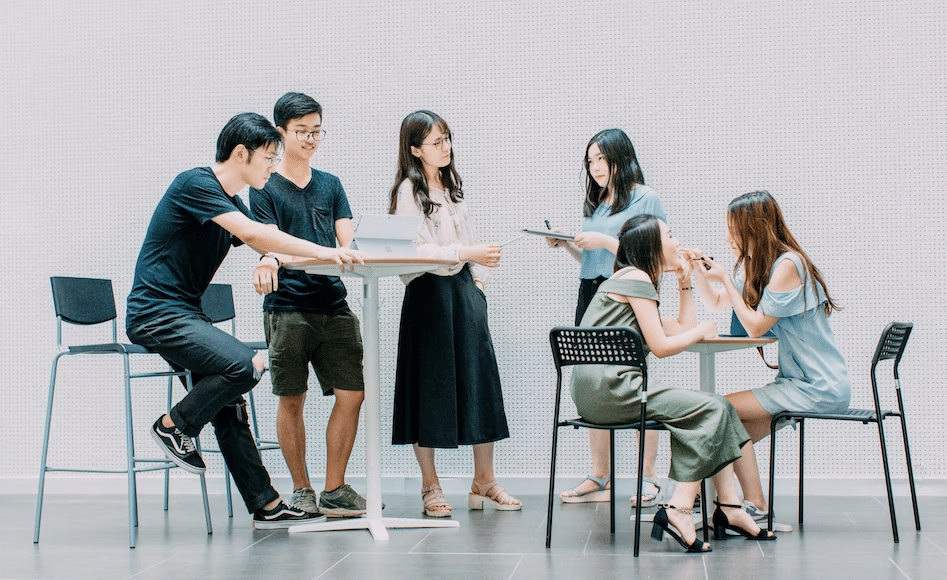The 4 Biggest Time Wasters In the Workplace | How To Avoid Them?

In today’s fast-paced and competitive work environment, time is undoubtedly one of the most valuable resources available to any organization or individual.
However, despite the best efforts of managers and employees alike, it can be all too easy to fall into the trap of wasting time on non-essential or unproductive activities.
Identifying and addressing BIG time wasters in the workplace is essential for maintaining productivity and achieving organizational goals.
Here are some quick solutions to avoid time wasters in the workplace to improve your team’s performance:
1. Create An Accountability System: It is an effective way to prevent time wasters, including setting specific goals, prioritizing tasks, and tracking time spent on each task. Utilizing time tracking software can help ensure accurate tracking of time spent on tasks and provide valuable insights into areas for improvement.
Best Time Tracking Software: Buddy Punch
2. Schedule Open Hours: It is another great way to avoid interruptions. Individuals can increase their focus and productivity by dedicating specific blocks of time each day for uninterrupted work. Meeting scheduling tools can be useful in managing interruptions by allowing individuals to set availability and schedule meetings without the back-and-forth of email communication.
Best Scheduling Software: Calendly
We will explore the 4 biggest time wasters in the workplace and provide practical tips on how to avoid them.
We will also explore what are time wasters and what are not and how to identify time wasters in your workplace.
By understanding and addressing the time wasters, employees and managers can improve productivity, reduce stress and achieve better results in less time.
- Biggest Workplace Time Wasters | Top 4 Issues
- What Is Not a Time Waster?
- How To Identify The Time Wasters In Your Workplace?
| What Is “Time Wasters”? ⌛ |
| Whether you are an accountant, a manager, or an entrepreneur, we are all guilty of wasting time. Time wasters basically refer to activities or behaviors that consume time but do not contribute to achieving important goals or tasks. These can include both intentional and unintentional distractions that derail focus and productivity. Time wasters can take many forms, such as scrolling through social media feeds, engaging in unproductive meetings or discussions, procrastinating on important tasks, or even getting bogged down in low-priority work. Time wasters can have a significant impact on productivity and overall success. They can lead to missed deadlines, lower-quality work, and increased stress and frustration. In addition, they can prevent individuals from reaching their full potential and achieving their personal and professional goals. |
Biggest Workplace Time Wasters | Top 4 Issues

In the workplace, there are several time wasters that can derail productivity and prevent individuals from achieving their goals.
Here are the top four biggest time wasters.
1. Procrastination

Procrastination is one of the most common time wasters.
Someone who constantly puts things off or waits until the last minute to get things done is someone who fails to see the importance of the task at hand or may feel that they have better things to do.
When you procrastinate, you waste a lot of time and energy that could be better spent on completing tasks and achieving goals. It leads to missed deadlines, lower-quality work, and increased stress and anxiety.
How to Avoid Procrastination?
Instead of allowing workers to delay things until the last minute, it is essential to identify the root cause of the behavior and implement strategies for combating procrastination, including:
- Break tasks into smaller, more manageable steps: Breaking down tasks into smaller components is a specific time management technique that can help overcome procrastination.
- Set realistic goals and deadlines: By setting time limits and goals, you can better track your progress and stay motivated to complete tasks.
- Prioritize tasks based on importance and urgency: Creating a to-do list and prioritizing tasks based on their significance helps you stay organized and focused on what needs to be done.
- Create a structured plan for completing tasks: Having an organizational system in place, such as a calendar or planner, helps you allocate your work time effectively and reduces the chances of procrastination.
- Seek accountability from a colleague or supervisor to stay on track: By involving team members or a supervisor in your work process, you can increase employee accountability and reduce the temptation to procrastinate.
To implement the above strategies, using time tracking software can be a helpful tool for avoiding procrastination. It helps you keep track of time and stay on top of your tasks. Time tracking software enables individuals to:
- Track how they spend their time: By monitoring the amount of time spent on different activities, you can identify areas where you may be wasting precious time.
- Identify areas for improvement: Time tracking software allows you to analyze your workday and discover opportunities for better time management.
- Better prioritize tasks: With the help of time tracking software, you can allocate specific time slots to different tasks and ensure that you focus on the most important ones first.
- Increase accountability: By having a record of your time spent and progress made, you become more accountable for your work and less likely to be distracted by online distractions or text messages.
Try Buddy Punch For Free
By using time tracking software, workers can avoid multitasking, create a structured plan for their day, and stay focused on their work without falling prey to procrastination.
2. Prone to Interrupting

Time wasters tend to be the ‘busy bees’ in the office, always going around and interrupting progress and disturbing others from what they are doing.
Push notifications and unnecessary meetings are interruptions, and interruptions are time wasters. According to Gloria Mark, it takes an average of 23 minutes to return to work after an interruption.
Notifications and meetings are particularly insidious as they are not just any form of interruption but an attractive interruption that can be difficult to resist. This is because humans have a natural inclination to follow the path of least resistance, as evidenced by research.
A driven workforce is one where everyone happily works together toward the same goals, not one where workers flit from coworker to coworker, constantly disrupting the workflow.
So, keep an eye out for those who seem “overly busy” and constantly bother other employees with mundane questions or chit-chat. In other words, look for “chatty coworkers.”
This is often a sign of an employee who may be confused about their exact role in the company or who fails to see how they fit into the bigger picture.
How to Avoid Interruptions?
To avoid being prone to interrupting, here are some strategies that can be helpful:
- Prioritize tasks based on urgency: It is important to prioritize tasks based on their importance and urgency to ensure that the most critical tasks are completed first.
- Use communication tools effectively: Communicate with colleagues effectively, and set time expectations around response times for emails and instant messages.
- Eliminate unnecessary meetings: Unnecessary meetings can be a major source of interruptions, so it is important to eliminate those that are not essential.
In addition to implementing the above strategies, scheduling open hours is another effective way to avoid interruptions.
Using scheduling software like Buddy Punch can help minimize interruptions and increase productivity.
These tools allow individuals to set their availability and schedule meetings without the need for time-consuming email exchanges.
3. Regularly Distracted

In today’s world, the average person checks their smartphone around 150 times a day, starting from the moment they wake up till the moment they fall asleep.
While modern technology has significantly enhanced our connectivity, knowledge, and efficiency, this convenience comes at the expense of constant and unrelenting distractions.
Many of you believe that notifications, alarms, and pop-ups don’t significantly impact your productivity. In fact, these small distractions are some of the most significant time-wasters of all.
While your employees should take the occasional break, most of their time, they should focus on their work. According to Zippia, 20% of employees waste their time because they’re mostly bored, or their job is not that much interesting.
Look out for workers who are easily distracted by videos online, things on their phones, or other non-work activities.
Scientists have found that distractions have an alarming effect on our productivity, with the typical office worker being interrupted every 11 minutes. Even more worrying is that it can take up to 25 minutes to focus on a task after being interrupted.
The pervasive nature of constant distractions can significantly diminish your cognitive abilities.
For instance, a study by the New York Times found that students who experienced even small interruptions in the middle of a cognitive test performed 20% worse than those who could maintain their focus uninterrupted.
How to Avoid Distractions?
If this is a common issue with your workers, consider holding them accountable for completing a specific amount of work by the day’s end. Or, motivate them with a monthly bonus if they meet predetermined goals.
Here are some strategies to help avoid getting regularly distracted:
- Create a distraction-free environment: Try to create an environment that is free of distractions. This can be done by eliminating unnecessary noise, turning off notifications, and finding a quiet workspace.
- Prioritize tasks: Prioritizing tasks is key to staying focused. This helps ensure that the most critical tasks are completed first and reduces the risk of distractions while working on important tasks.
- Limit social media and email usage: Social media and email can be a major source of distractions. Limiting their usage during work hours can help individuals stay focused.
Using communication software effectively is crucial in managing distractions in the workplace. Popular communication software options include Slack, Microsoft Teams, and Zoom.
These tools allow for efficient communication and collaboration, reducing the need for in-person meetings and lengthy email threads.
They also offer features like notification settings and message organization, allowing individuals to manage their communications effectively.
4. Constantly Asks Questions

New employees might need extra help learning the ropes, but once trained, they should be ready to do their job without needing constant clarification.
While asking the occasional question can demonstrate a genuine concern for doing a good job, it becomes a problem when a worker repeatedly asks unnecessary questions about tasks they have already been trained in.
In such cases, it’s important to have a one-on-one conversation with the employee to understand the root cause of the behavior and address it appropriately.
They may have missed out on a key part of the training or lacked the confidence to do their job. If training is an issue, you can always reorient them.
If confidence is the issue, you’ll want to tell them that you’re confident that they can make the right decisions and provide encouragement, giving them more responsibility as their self-assurance improves.
How To Avoid Unnecessary Questions?
Avoiding unnecessary questions in the workplace can help save time and improve productivity. Here are some strategies to help minimize this issue:
- Encourage self-sufficiency: Encouraging colleagues to become more self-sufficient can help reduce the need for constant questions.
- Provide resources: Providing resources like manuals, guidelines, and FAQs can help reduce the need for repetitive questions.
- Schedule check-ins: Schedule regular check-ins with colleagues to address any questions or concerns they may have. This helps ensure that questions are addressed in a timely manner.
Establishing clear boundaries and expectations is the best way to handle a colleague who frequently interrupts with questions.
Additionally, consider using digital communication tools like email or instant messaging to address minor questions or concerns.
Ready to start a free trial?
No credit card required, all features included.
What Is Not a Time Waster?
When it comes to time management, many people focus on avoiding time wasters to maximize their productivity.
While it’s essential to eliminate activities that don’t contribute to your goals, it’s equally important to recognize what is not a time waster.
Here are three examples of activities that are not time wasters:
1. Rest
Taking breaks and giving yourself time to rest is crucial for productivity. Rest allows you to recharge your energy and focus, making you more effective when you return to work.
Skipping breaks and working long hours without rest can lead to burnout, negatively impacting your health and productivity.
So, don’t underestimate the value of rest when managing your time.
2. Socialization
While it’s important to focus on your work, socializing with colleagues and building relationships can be beneficial in the long run.
Building positive relationships with coworkers can create a supportive work environment, leading to increased job satisfaction and productivity.
It’s important to balance socializing and working to maintain focus and productivity.
3. Sleep
Getting enough sleep is essential for optimal performance. Sleep allows your body and brain to recharge, consolidate memories, and process information.
When you don’t get enough sleep, your cognitive abilities and decision-making skills can be impaired, leading to decreased productivity.
So, make sure that you prioritize getting enough sleep to perform at your best.
How To Identify The Time Wasters In Your Workplace?
It is crucial to remember that what constitutes a time-waster can vary from person to person and circumstance to circumstance.
For instance, playing video games daily instead of attending to work responsibilities might be considered a waste of time for most people.
However, for your neighbor, who is a professional video gamer, playing video games could be seen as a means of training and improving their skills.
Despite these variations, it is possible to identify the time wasters in your workplace. The following steps will guide you in recognizing your personal time wasters and what you can do about them.
1. Set Goals
Setting goals is an essential step in identifying time wasters in the workplace.
Without a clear set of goals, it’s challenging to determine what activities are helping you achieve your objectives and what is merely wasting your time.
The goals should be specific, measurable, achievable, relevant, and time-bound (SMART).
Having a clear understanding of what you want to achieve makes it easier to prioritize your tasks and avoid time-wasting activities.
2. Assess What You Need To Do To Achieve These Goals
Once you have set your goals, you need to determine the tasks that will help you achieve them.
Assessing what you need to do to reach your goals is critical in identifying time-wasters. Take the time to create a detailed action plan outlining the specific tasks you need to complete.
As you create your plan, consider the steps necessary to accomplish your objectives and identify any potential roadblocks hindering your progress.
3. Track Time To Identify Patterns
Tracking your time is the most effective way to identify time-wasters in the workplace. You can use various tools, such as time-tracking apps or spreadsheets, to monitor your time spent on various tasks.
So, keep track of the time spent on each activity, including meetings, emails, and phone calls. It is important to be honest with yourself when tracking your time, even for activities you enjoy.
After a week or two, analyze the data to identify patterns. Look for activities that consume significant time but do not contribute to achieving your goals.
Once you have identified the time-wasters, take steps to eliminate or reduce them.
Wrapping Up,
Finally, it is also important to keep in mind that some of the biggest time wasters –are not people but are, in fact, systems or work processes.
It’s easy enough to spot a worker who’s constantly on social media, but other, more subtle time wasters tend to go unnoticed because they’re often disguised as necessary business activities.
Unnecessary meetings, for instance, can be a significant time waster. People are often called to meetings that don’t apply to them. Additionally, inefficient processes and paperwork overload have also been shown to be major timewasters.
Ultimately, managing your time throughout the day is up to you. It becomes your responsibility to set deadlines and prioritize tasks based on what is most important.
Try Buddy Punch for Free
Ready to give Buddy Punch a try?
For free trial, no credit card required.
Buddy Punch offers a 14-day free trial that anyone can sign up to test it out. You can also book a one-on-one demo, or view a pre-recorded demo video.